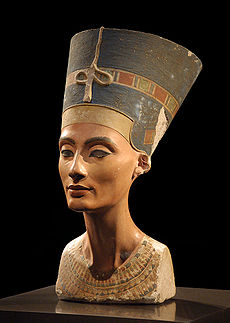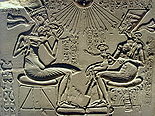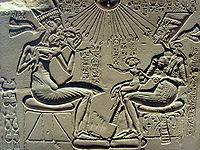- Nefertiti
-
This article is about the Ancient Egyptian Queen Nefertiti. For other uses, see Nefertiti (disambiguation).
Neferneferuaten-Nefertiti in hieroglyphs 












Neferneferuaten Nefertiti
Nfr nfrw itn Nfr.t jy.tj
Beauty of Aten, the Beautiful one has comeGreat Royal Wife of Pharaoh Akhenaten The bust of Nefertiti from the Ägyptisches Museum Berlin collection, presently in the Neues Museum.Nefertiti (ca. 1370 BC – ca. 1330 BC) was the Great Royal Wife (chief consort) of the Egyptian Pharaoh Akhenaten. Nefertiti and her husband were known for a religious revolution, in which they started to worship one god only. This was Aten, or the sun disc.
Nefertiti had many titles including Hereditary Princess (iryt-p`t), Great of Praises (wrt-hzwt), Lady of Grace (nbt-im3t), Sweet of Love (bnrt-mrwt), Lady of The Two Lands (nbt-t3wy), Main King’s Wife, his beloved (hmt-niswt-‘3t meryt.f), Great King’s Wife, his beloved (hmt-niswt-wrt meryt.f), Lady of all Women (hnwt-hmwt-nbwt), and Mistress of Upper and Lower Egypt (hnwt-Shm’w-mhw).[1]
She was made famous by her bust, now in Berlin's Neues Museum, shown to the right. The bust is one of the most copied works of ancient Egypt. It was attributed to the sculptor Thutmose, and it was found in his workshop. The bust is notable for exemplifying the understanding Ancient Egyptians had regarding realistic facial proportions. Some scholars believe that Nefertiti ruled briefly after her husband's death and before the accession of Tutankhamun as Neferneferuaten, although this identification is a matter of ongoing debate.[2]
Contents
Family
- See also : Eighteenth dynasty of Egypt Family Tree
Nefertiti, Egyptian Nfr.t-jy.tj, original pronunciation approximately Nafteta, for ("the beauty has come"). Nefertiti's parentage is not known with certainty, but one often cited theory is that she was the daughter of Ay, later to be pharaoh. Scenes in the tombs of the nobles in Amarna mention the queen’s sister who is named Mutbenret (previously read as Mutnodjemet).[3][4]
Another theory that gained some support identified Nefertiti with the Mitanni princess Tadukhipa.[5]
The exact dates of when Nefertiti was married to Akhenaten and later promoted to his Queen are uncertain. However, the couple had six known daughters. This is a list with suggested years of birth:[4][5]
- Meritaten: Before year one or the very beginning of year one.(1356 BC).
- Meketaten: Year 1 or three (1349 BC).
- Ankhesenpaaten, also known as Ankhesenamen, later queen of Tutankhamun
- Neferneferuaten Tasherit: Year 6 (1344 BC)
- Neferneferure: Year 9 (1341 BC).
- Setepenre: Year 11 (1339 BC).
Life
Nefertiti first appears in scenes in Thebes. In the damaged tomb (TT188) of the royal butler Parennefer the new king Amenhotep IV is accompanied by a royal woman, and this lady is thought to be an early depiction of Nefertiti. The king and queen are shown worshiping the Aten. In the tomb of the vizier Ramose Nefertiti is shown standing behind Amenhotep IV in the Window of Appearance during the reward ceremony for the vizier.[5]
 Close-up of a limestone relief depicting Nefertiti smiting a female captive on a royal barge. On display at the Museum of Fine Arts, Boston.
Close-up of a limestone relief depicting Nefertiti smiting a female captive on a royal barge. On display at the Museum of Fine Arts, Boston.
During the early years in Thebes Akhenaten (still known as Amenhotep IV) had several temples erected at Karnak. One of the structures, the Mansion of the Benben (hwt-ben-ben), was dedicated to Nefertiti. She is depicted with her daughter Meritaten and in some scenes the princess Meketaten participates in the scenes as well. In scenes found on the talatat Nefertiti appears almost twice as often as her husband. She is shown appearing behind her husband the Pharaoh in offering scenes in the role of the queen supporting her husband, but she is also depicted in scenes that would have normally been the prerogative of the king. She is shown smiting the enemy, and captive enemies decorate her throne.[6]
In the fourth year of his reign Amenhotep IV decided to move the capital to Akhetaten (modern Amarna). In his fifth year, Amenhotep IV officially changed his name to Akhenaten, and Nefertiti was henceforth known as Neferneferuaten-Nefertiti. The name change was a sign of the ever-increasing importance of the cult of the Aten. It changed Egypt's religion from a polytheistic religion to a religion which may have been better described as a monolatry (the depiction of a single god as an object for worship) or henotheism (one god, who is not the only god).[7]
The boundary stelae of years 4 and 5 mark the boundaries of the new city and suggest that the move to the new city of Akhetaten occurred around that time. The new city contained several large open-air temples dedicated to the Aten. Nefertiti and her family would have resided in the Great Royal Palace in the center of the city and possibly at the Northern Palace as well. Nefertiti and the rest of the royal family feature prominently in the scenes at the palaces and in the tombs of the nobles. Nefertiti’s steward during this time was an official named Meryre II. He would have been in charge of running her household.[2][5]
Inscriptions in the tombs of Huya and Meryre II dated to Year 12, 2nd month of Peret, Day 8 show a large foreign tribute. The people of Kharu (the north) and Kush (the south) are shown bringing gifts of gold and precious items to Akhenaten and Nefertiti. In the tomb of Meryre II, Nefertiti’s steward, the royal couple is shown seated in a kiosk with their six daughters in attendance.[2][5]
This tribute from year 12 is one of the last times princess Meketaten is shown alive. Meketaten may have died in year 13 or 14. Nefertiti, Akhenaten, and three princesses are shown mourning Meketaten.[8] Nefertiti disappears from the scene soon after that.[5]
Death
About Year 14 of Akhenaten's reign, Nefertiti vanishes from the historical record. There is no word of her after that date. Theories include sudden death by a plague that was sweeping through the city or another natural death. This theory is based on the discovery of several shabti fragments inscribed for Nefertiti (now located in the Louvre and Brooklyn Museums).
A previous theory that she fell into disgrace is now discredited, since the deliberate erasures of monuments belonging to a queen of Akhenaten have been shown to refer to Kiya instead.[4]
During Akhenaten's reign (and perhaps after), Nefertiti enjoyed unprecedented power. The Coregency Stela may show her as a co-regent with her husband. By the twelfth year of his reign, there is evidence that she may have been elevated to the status of co-regent:[9] equal in status to the pharaoh. It is possible that Nefertiti is to be identified as the ruler named Neferneferuaten. Some theories believe that Nefertiti was still alive and held influence on the younger royals. If this is the case, that influence and presumably Nefertiti's own life would have ended by year 3 of Tutankhaten's reign (1331 BC). In that year, Tutankhaten changed his name to Tutankhamun. This was evidence of his return to the official worship of Amun, and his abandonment of Amarna to return the capital to Thebes.[2]
Burial
There are many theories regarding her death and burial but to date, the mummy of this famous and iconic queen has not been found or identified.
"Younger Lady"
Main article: The Younger Lady (mummy)On June 9, 2003, archaeologist Joann Fletcher, a specialist in ancient hair from the University of York in England, announced that Nefertiti's mummy may have been one of the anonymous mummies stored in tomb KV35 in the Valley of the Kings known as "the Younger Lady". The independent scholar Marianne Luban had published similar speculation in 1999 in an article posted on the Internet, entitled "Do We Have the Mummy of Nefertiti?"[10]
Luban's points upholding the identification are the same as those of Joann Fletcher. Furthermore, Fletcher suggested that Nefertiti was the Pharaoh Smenkhkare. Some Egyptologists hold to this view though the majority believe Smenkhkare to have been a separate person. Dr. Fletcher led an expedition funded by the Discovery Channel that examined what they believed to have been Nefertiti's mummy.
The team claimed that the mummy they examined was damaged in a way suggesting the body had been deliberately desecrated in antiquity. Mummification techniques, such as the use of embalming fluid and the presence of an intact brain, suggested an eighteenth-dynasty royal mummy. Other elements which the team used to support their theory were the age of the body, the presence of embedded nefer beads, and a wig of a rare style worn by Nefertiti. They further claimed that the mummy's arm was originally bent in the position reserved for pharaohs, but was later snapped off and replaced with another arm in a normal position.
Most Egyptologists, among them Kent Weeks and Peter Locavara, generally dismiss Fletcher's claims as unsubstantiated. They say that ancient mummies are almost impossible to identify as a particular person without DNA. As bodies of Nefertiti's parents or children have never been identified, her conclusive identification is impossible. Any circumstantial evidence, such as hairstyle and arm position, is not reliable enough to pinpoint a single, specific historical person. The cause of damage to the mummy can only be speculated upon, and the alleged revenge is an unsubstantiated theory. Bent arms, contrary to Fletcher's claims, were not reserved to pharaohs; this was also used for other members of the royal family. The wig found near to the mummy is of unknown origin, and cannot be conclusively linked to that specific body. Finally, the 18th dynasty was one of the largest and most prosperous dynasties of ancient Egypt. A female royal mummy could be any of a hundred royal wives or daughters from the 18th dynasty's more than 200 years on the throne.
In addition, there was controversy about both the age and sex of the mummy. On June 12, 2003, Hawass also dismissed the claim, citing insufficient evidence. On August 30, 2003, Reuters further quoted Hawass: "I'm sure that this mummy is not a female", and "Dr Fletcher has broken the rules and therefore, at least until we have reviewed the situation with her university, she must be banned from working in Egypt."[11] On different occasions, Hawass has claimed that the mummy is female and male.[12]
In a more recent research effort led by Egyptian archaeologist Dr. Zahi Hawass, head of Egypt's Supreme Council for Antiquities, the mummy known as "The Younger Lady" was put through CT scan analysis. Researchers concluded that she may be Tutankhamun's biological mother, an unnamed daughter of Amenhotep III and Queen Tiye, not Queen Nefertiti. Fragments of shattered bone were found in the sinus, and blood clots were found. The theory that the damage was inflicted post-mummification was rejected, and a murder scenario was deemed more likely. The broken-off bent forearm found near the mummy, which had been proposed to have belonged to "The Younger Lady" mummy, was conclusively shown not to actually belong to it. Scholars think that, after Tutankhamun returned Egypt to the traditional religion, he moved his closest relatives: father, grandmother, and biological mother, to the Valley of the Kings to be buried with him (according to the list of figurines and drawings in his tomb). Nefertiti may be in an undiscovered tomb.
"Elder Lady"
A KMT article called "Who is The Elder Lady mummy?" suggested in 2001 that the elder lady mummy may be Nefertiti's body.[13] It was argued that the evidence suggests that the mummy is around her mid-thirties or early forties, Nefertiti's guessed age of death. More evidence to support this identification was that the mummy's teeth look like that of a 29-38 year old, Nefertiti's most likely age of death. Also, unfinished busts of Nefertiti appear to resemble the mummy's face, though other suggestions included Ankhesenamun and, the favorite candidate, Tiye.
Due to recent age tests on the mummy's teeth, it appears that the 'Elder Lady' is in fact Queen Tiye and also that the DNA of the mummy is a close, if not direct, match to the lock of hair found in Tutankhamun's tomb. The lock of hair was found in a coffinette bearing an inscription naming Queen Tiye. [14] Recent DNA testing has proved the elder Lady is a daughter of Yuya and Thuya, therefore she is identified as Queen Tiye, mother of Akhenaten.
Iconic status
Nefertiti's place as an icon in popular culture is secure as she has become somewhat of a celebrity. After Cleopatra she is the second most famous "Queen" of Ancient Egypt in the Western imagination and influenced through photographs that changed standards of feminine beauty of the 20th century, and is often referred to as "the most beautiful woman in the world".[15]
In the arts
Novels
- Mika Waltari, The Egyptian (1945).
- Allen Drury, God Against the Gods (1978). Story of Akhenaten and Nefertiti.
- Mwaffaq Irshaidat, Ein Shams Journal (1975). A love story in the early Egyptian Days - A Jordanian point of view.
- Naguib Mahfouz, Akhenaten, Dweller in Truth (1985) Nefertiti is one of the characters who reflects on Akhenaten and the Amarna period
- Michelle Moran: Nefertiti: A Novel. (Crown, 2007).
- Nick Drake: Nefertiti: The Book of the Dead. (Harper, 2008).
- Esther Friesner: Sphinx's Princess. (Random House, 2009).
Poetry Dave Malone in his poem, "A Long Weekend" in Poems to Love and the Body (Bliss Station, 1998; Smashwords, 2010), weaves a modern-day love poem with references to Nefertiti, King Akhenaten, and the city, Akhetaten (Amarna).
Film
- (1954) The Egyptian, played by Anitra Stevens
- (1961) Nefertiti, Queen of the Nile, played by Jeanne Crain
- (1994) Nefertiti, figlia del sole, played by Michela Rocco di Torrepadula
References
- ^ Grajetzki, Ancient Egyptian Queens: A Hieroglyphic Dictionary, Golden House Publications, London, 2005, ISBN 978-0954721893
- ^ a b c d Dodson, Aidan, Amarna Sunset: Nefertiti, Tutankhamun, Ay, Horemheb, and the Egyptian Counter-Reformation. The American University in Cairo Press. 2009, ISBN 978977416304-3
- ^ Egypt State Information Service - Famous women
- ^ a b c Dodson, Aidan and Hilton, Dyan. The Complete Royal Families of Ancient Egypt. Thames & Hudson. 2004. ISBN 0-500-05128-3
- ^ a b c d e f Tyldesley, Joyce. Nefertiti: Egypt's Sun Queen. Penguin. 1998. ISBN 0-670-86998-8
- ^ Redford, Donald B. Akhenaten: The Heretic King. Princeton University Press. 1987. ISBN 978-0691002170
- ^ Dominic Montserrat, Akhenaten: History, Fantasy and Ancient Egypt, Psychology Press, 2003
- ^ Murnane, William J., Texts from the Amarna Period in Egypt, Society of Biblical Literature, 1995 ISBN 1-55540-966-0
- ^ Reeves, Nicholas. Akhenaten: Egypt's False Prophet. p.172 Thames & Hudson. 2005. ISBN 0-500-285527
- ^ Do We Have the Mummy of Nefertiti?
- ^ Hawass comments - No Discrimination
- ^ Times Online - King Tut tut tut
- ^ [1][dead link]
- ^ Hawass, Zahi et al. "Ancestry and Pathology in King Tutankhamun's Family" The Journal of the American Medical Association p.640-641
- ^ Queen Nefertiti of Egypt
External links
Amarna Period Pharaohs 
Royal Family Royal Children Meritaten · Meketaten · Ankhesenpaaten · Neferneferuaten Tasherit · Neferneferure · Setepenre · Baketaten · Meritaten Tasherit · Ankhesenpaaten TasheritNobles and officials Locations Other List of ancient Egyptians Consorts Neithhotep · Tetisheri · Ahhotep I · Ahmose-Nefertari · Ahmose · Tiye · Nefertiti · Ankhesenamun · NefertariCourt officials Imhotep · Weni · Sobeknakht II · Ahmose-Ebana · Ineni · Senenmut · Rekhmire · Yuya · Amenhotep, son of Hapu · Maya · Yuny · Bay · Manetho · PothinusCategories:- Ancient Egyptian queens consort
- Eighteenth dynasty of Egypt
- 14th-century BC women
- Amarna Period
Wikimedia Foundation. 2010.



